LisbonLisboaPortugal.com
The best independent guide to Lisbon
LisbonLisboaPortugal.com
The best independent guide to Lisbon
Lisbon to Porto; an independent guide on how best to travel in 2025
Lisbon and Porto are the largest cities in Portugal, with each boasting its own unique character and appeal.
Lisbon is the vibrant capital city of Portugal, and is also home to the country’s main international airport. Porto is more traditional and is famed for its production of Port wine. Both cities make fantastic bases from which to explore their surrounding regions and can be easily combined during a holiday to Portugal.
There are many transport options between these two main cities, including express trains, intercity buses, or by car along the A1 toll expressway.
In our opinion, the best way to travel from Lisbon to Porto is by express train, which can be as quick as 2 hours 49 minutes and costs from €26.85. Express buses have marginally longer journey times, from around 3 hours 15 minutes, but tickets can cost as little as €7.99.
This article will provide an independent guide on how best to travel from Lisbon to Porto, as well as providing links to transport companies and useful travel advice.
Related articles: Porto guide - Lisbon guide
Lisbon to Porto, the transport options
Porto is situated 310km to the north of Lisbon, and there are many options for travelling between the two cities. These include:
Private transfer – The fastest and most convenient way to travel between Lisbon and Porto. However, it is also the most expensive, with prices around €400. This may be a good option if you are travelling as a group of four. A private transfer can be provided by GetYourGuide.com.
Driving along the A1 expressway – The quickest driving route follows the A1 expressway north/south as it cuts through the centre of Portugal. The route is 310km long and takes 3 hours, but the tolls are expensive, costing €22.40. Also, driving in both Lisbon and Porto is demanding, with busy roads, erratic drivers and limited parking.
Warning: If travelling by car, please be aware of tolls and how to pay them. Details are provided at the end of this guide. Brisa, the company that manages the roads, has recently discovered that foreign tourists are a great source of funds and is quick to issue fines – it has even been sending out fines from 5 years ago!
Train travel – The most comfortable way to travel between Lisbon and Porto is by train. Both cities are connected by express trains called the Alfa Pendular (AP), with the journey taking 2 hours 49 minutes and a single ticket costing €33.90. There are slightly cheaper Intercidades (Intercity) trains, with fares costing €26.85, but these have a longer journey time of 3 hours 14 minutes. The national train company of Portugal is Comboios de Portugal (CP), and full details are provided in later sections.
Bus - Rede Expressos – Rede Expressos is the main intercity bus company of Portugal, and provides many direct services between Lisbon and Porto. Bus travel is much cheaper than train (typical bus fare is between €10 and €25), and journeys are fast, with few stops. The fastest bus service takes just 3 hours 15 mins, only 20 minutes longer than by car. The buses are modern and comfortable, and intercity bus travel is safe in Portugal - rede-expressos.pt
Bus, FlixBus – A low-cost bus operator that has driven down the price of coach travel in Portugal. FlixBus is the best option if you are a budget traveller, with fares as low as €7.99 if booked far enough in advance. The downside is that popular services do sell out, and its buses are always much busier than those of Rede Expressos - FlixBus
Flying – The short journey time between Lisbon and Porto means flying is not a sensible option, especially when you factor in check-in and security.
Advice: Whichever option you choose, it always makes sense to book directly with the transport company instead of third-party ticket resellers. Buying directly will reduce booking fees and ensure each company is more accommodating if there are issues. Links to their websites are:
Comboios de Portugal - www.cp.pt
Rede Expressos - rede-expressos.pt
Flixbus - FlixBus
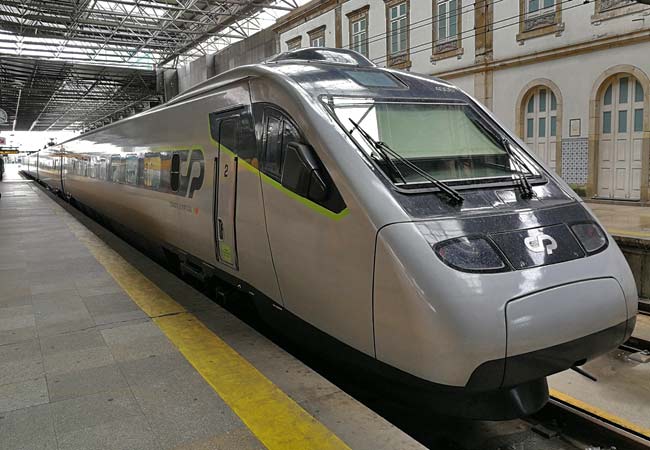
The Alfa Pendular trains are the fastest way to travel around Portugal.
Train, bus, or low-cost bus travel between Lisbon and Porto?
Bus and train travel is very comparable when travelling between Lisbon and Porto. The main differences are the level of comfort and cost. Train travel is more spacious and comfortable than bus, but it is more expensive.
For the journey, we would recommend taking the fast and modern Alfa Pendular train. If you are a budget-conscious traveller, you should choose FlixBus. FlixBus and Rede Expressos use very similar buses, the main difference is that FlixBus will be 80 per cent full and Rede Expressos 45 per cent full.
Public transport is exceptionally good value in Portugal; two adult train fares from Lisbon to Porto costs approximately the same as the tolls and fuel when driving.
Insight: We never recommend hiring a car purely for the journey from Lisbon to Porto. Driving along the A1 is very easy, but it can be extremely challenging in the cities, with heavy traffic, confusing road layouts and extremely limited parking.
The remainder of this article will discuss travelling from Lisbon to Porto by train and bus, including details of the stations and an overview of the different services.
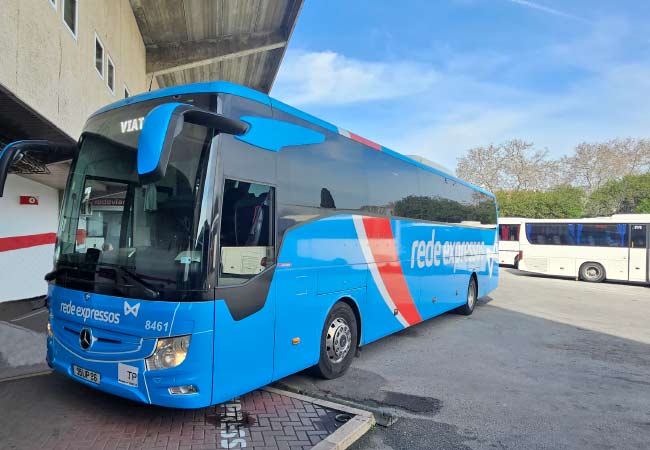
Lisbon to Porto by train
The railway between Lisbon and Porto is fast, safe and modern. There are two different train services between Lisbon and Porto; the express Alfa Pendular (AP) and the Intercidades (IC - intercity).
The Alfa Pendular service is faster and offers a high standard of comfort and facilities, such as free Wi-Fi and more legroom. The Intercidades have a longer journey time, as there are more stops along the route.
Both Alfa Pendular and Intercidades provide direct routes from Lisbon to Porto and depart/arrive at the same stations. A summary of the train services between Lisbon and Porto can be seen on the CP website:
www.cp.pt/
This link is a PDF, so it may download on certain mobile phones.
The Alfa-Pendular train journey takes 2 hours 40 minutes, while the intercity train service takes 3 hours 10 minutes. A single ticket on the Alfa Pendular train from Lisbon to Porto costs €47.40/€33.90 (1st/2nd), while the Intercidades costs €39.75/€26.85 (1st/2nd).
There are reductions for children (50 per cent discount), under 25s (25 per cent discount), seniors 65+ (50 per cent discount) or when buying a return ticket (10 per cent reduction). These age-related discounts can be applied when purchasing online, during the ‘options’ stage of the booking process. If using any age-based discounts, always travel with valid ID to prove your age.
Train tickets must be pre-booked, as each ticket is for a designated a seat - and the number of seats is limited.
Popular train services do sell out, especially during the peak season, so it is advisable to book tickets as far in advance as possible.
Warning: There is no standing room on the Alfa-Pendular or Intercidades; when all of the seats are sold, there is no way to travel on the train. Always book important journeys well in advance during the peak season!
Insight: There is often lots of confusion when the train arrives as to which carriage your seats are in. On your ticket, you will see the words ‘Carruagem’ (carriage) and ‘Lugar’ (seat number). The carriage number will be displayed on a small sign close to each carriage door. For example, the carriage number ‘21’ will represent the first carriage of the second class – and it doesn’t mean that there are 21 carriages!
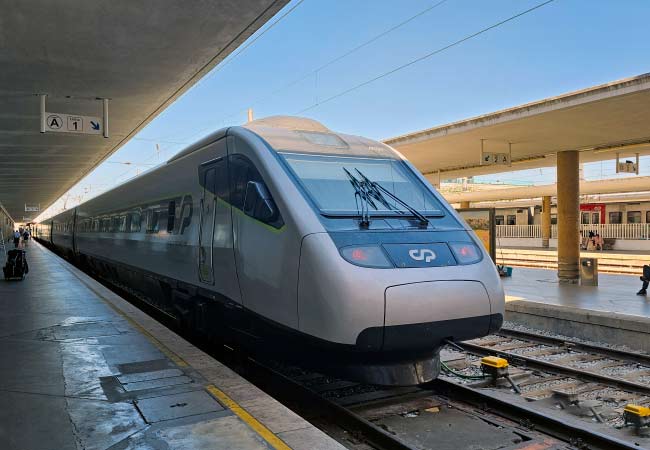
The Alfa Pendular waiting in Santa Apolónia train station.
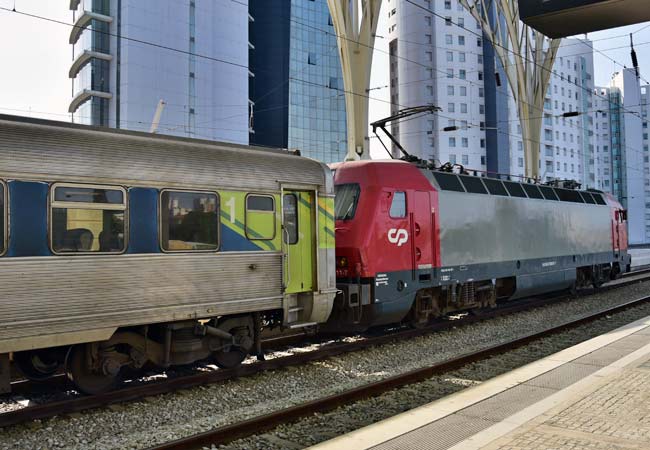
The Intercidade train to Porto
Lisbon’s train stations
In Lisbon, there are two train stations from which the Lisbon to Porto express trains depart: Oriente and Santa Apolónia.
All express trains to and from Porto stop at Oriente Station, while the majority also stop at Santa Apolónia.
Insight: The Algarve to Lisbon to Porto Alfa Pendular express trains do not stop at Santa Apolónia. It is advisable to always confirm your departure station on your ticket.
Santa Apolónia train station is located on the southern side of the Alfama district (GPS 38.714, -9.122) and is convenient for most visitors, as it is close to the historic centre of Lisbon. If you are based in the Baixa, Alfama or Cais do Sodré districts, this is the best station to transit through.
Santa Apolónia train station is the final stop on the blue metro. The station has six platforms, but is very easy to navigate and has a much calmer atmosphere than Oriente.
The Oriente train station is located to the northeast of Lisbon and is situated in the Parque das Nações district, GPS: 38.7675, -9.099.
Oriente Station is only 3 kilometres from the airport, and this is the best train station if you are travelling directly from the airport. Both the airport and Oriente station are on the red metro line.
Related articles: Estação do Oriente - Santa Apolonia
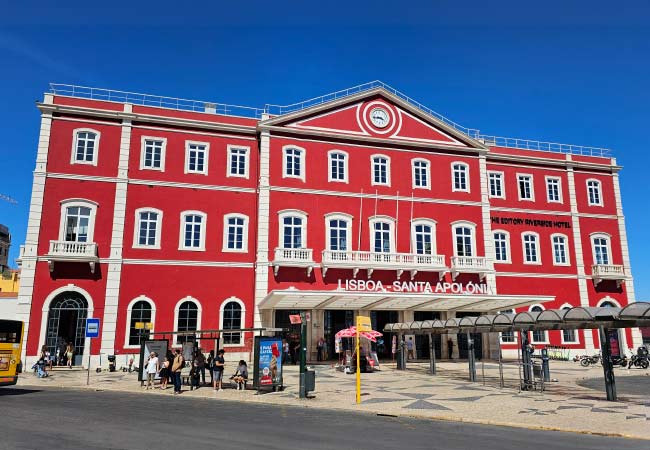
The Santa Apolónia station is on the edge of the Alfama district and is convenient for most tourists.
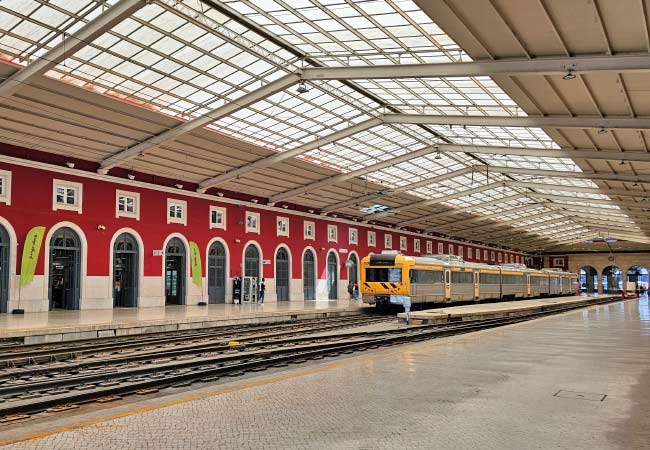
Santa Apolónia is a calm and easy station to travel through.
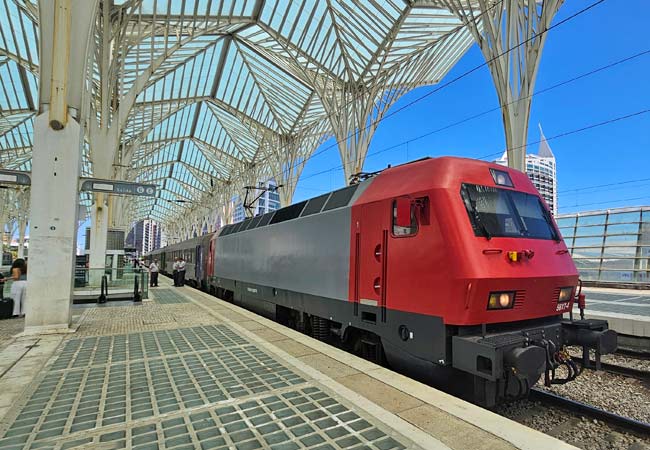
The Estação do Oriente was inspired by Gothic architecture.
Porto’s train stations
In Porto, all express train services stop at Campanhã train station. This station is located 2.5km east of Porto's historic centre, at GPS 41.150, -8.585.
Most tourists have accommodation close to the historic centre, and this area is served by the São Bento train station. However, the Lisbon to Porto express trains do not stop here. There are regular urban trains from Campanhã to São Bento, and this six-minute journey is included in your ticket.
For convenience, you may wish to take an Uber, Bolt or taxi for this short journey from Campanhã train station to your final destination. An Uber fare from Campanhã to the centre of Porto typically costs only €4 to €5.
If your accommodation is on the south side of the Douro River, you may wish to consider exiting the train at Vila Nova de Gaia, GPS 41.129, -8.619. This is a small train station, but it is only a 650-metre downhill walk to the waterfront of Vila Nova de Gaia.
Insight: Vila Nova de Gaia is often abbreviated to V. N. Gaia on timetables and on the Comboios de Portugal website.
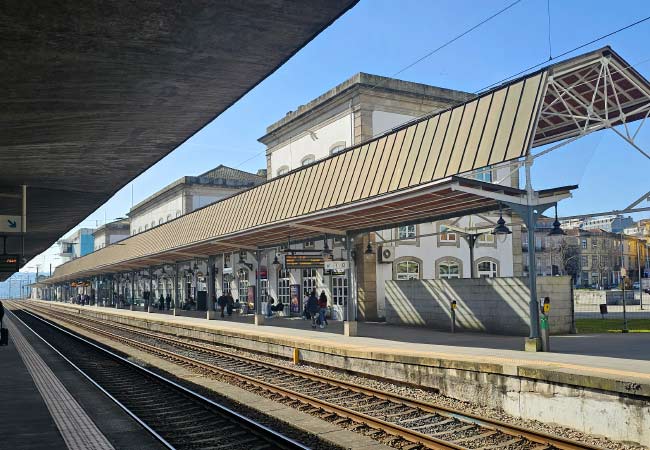
Campanhã train station
Lisbon to Porto by Bus
Bus travel in Portugal is safe and inexpensive, and the buses used by Rede Expressos and FlixBus are smart and modern.
The main intercity coach company in Portugal is Rede Expressos, which provides multiple express services between Lisbon and Porto. There are over 20 daily departures, and the journey can be as short as 3 hours 15 minutes.
Insight: Rede Expressos is a conglomerate comprising many smaller bus companies, and certain Lisbon to Porto routes may be provided by Renex.
FlixBus is a low-cost bus company that provides services along many of the more popular routes in Portugal. Since it started operating, the price of bus travel has significantly fallen and is now much cheaper than train travel.
FlixBus services are generally cheaper than those of Rede Expressos when booked in advance, but they often sell out during popular times. Also, expect FlixBus to be much busier than the Rede Expressos equivalent.
Both Rede Expressos and FlixBus employ dynamic pricing, with the cost of the ticket increasing closer to the departure time and with demand. Fares between Lisbon and Porto can start from as little as €5.99 with FlixBus, and are always much cheaper than the train.
For the latest timetables and to purchase tickets, please visit the Rede Expressos or FlixBus websites:
Rede Expressos - rede-expressos.pt/
Flixbus - FlixBus
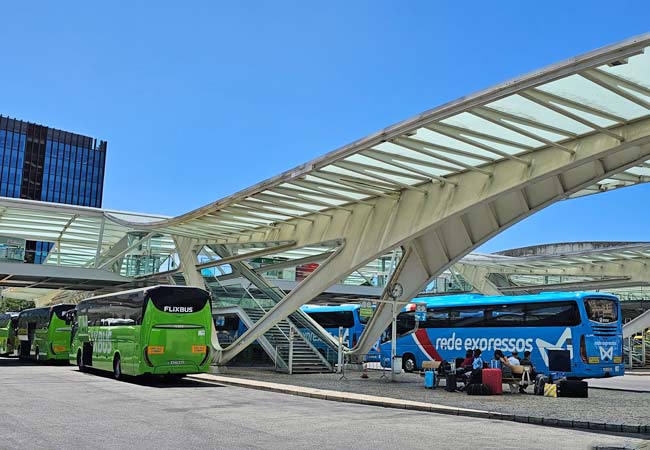
FlixBus and Rede Expressos buses waiting at Oriente bus station.
Lisbon and Porto Bus Stations
There are two intercity bus stations in Lisbon: Sete Rios and Oriente.
Sete Rios bus station is solely used by Rede Expressos, but due to its limited size and capacity, certain Rede Expressos routes depart from Oriente. All FlixBus services depart from and terminate at Oriente bus station.
Insight: Always confirm your departure location on your ticket.
The Sete Rios Bus Station is located to the north of Lisbon (GPS: 38.741, -9.166) and is connected to the blue metro line by the Jardim Zoológico metro station. The bus station is a busy transport hub with many departures, a large ticket office, and multiple snack shops and cafes.
The Oriente bus station (GPS: 38.767, -9.099) is situated in the Parque das Nações district, to the northeast of the city. Oriente bus station is connected to Oriente train station and is served by the red metro line. This bus station is very spread out and confusing to navigate; always give yourself enough time to find your departure location.
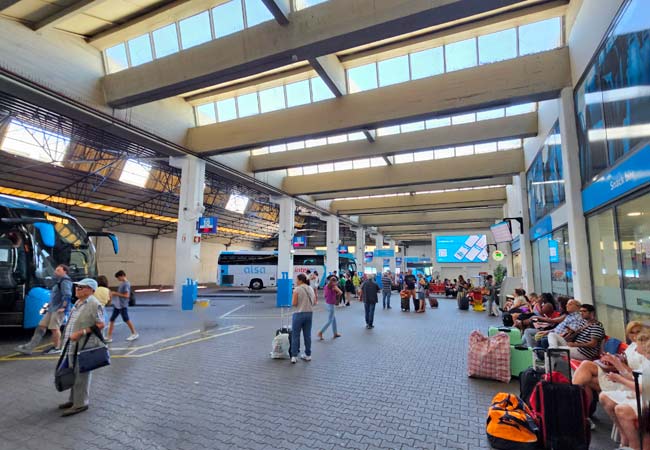
Sete Rios is a busy bus station.
In Porto, the intercity bus terminal is the Terminal Intermodal de Campanhã, often abbreviated to TIC or simply referred to as Campanhã. It is situated east of the city centre at GPS 41.151, -8.582 and is connected to the Campanhã train and metro station. Both FlixBus and Rede Expresso depart from and terminate at Campanhã.
There are two options for travelling to Porto's historic centre from Campanhã bus station: the metro or the train. The train offers a shorter journey time but is less frequent, while the metro necessitates a connection at Trindade. For this short journey, an Uber, Bolt or taxi often proves a better option, especially if you are travelling with heavy luggage.
Portugal’s bus stations are generally safe, but you should remain vigilant when passing through, as pickpockets are always on the lookout for easy opportunities.
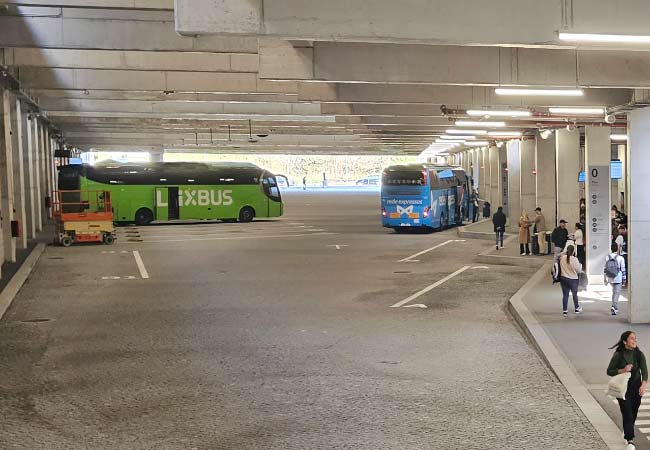
Campanhã bus station
Driving between Lisbon and Porto via the A1
The journey from Lisbon to Porto follows the A1 expressway. This road has tolls, and the cost will be €21.50, almost the same as the cost of a train ticket.
The tolls are paid through the Via Verde transponder, which you should ask for if you are renting a car in Portugal. Full details are provided on their website:
visitors.viaverde.pt
If you are planning on driving a foreign registered car, please see this website:
www.portugaltolls.com/
It is highly recommended to have a Via Verde transponder while driving in Portugal, as many expressways only have automatic toll collection. To estimate the cost of tolls in Portugal, use the website:
https://
Discover more of Lisbon with our most popular guides
If you've found our content valuable, we'd welcome your support.
The digital publishing landscape has evolved significantly. As a small independent publisher, we face growing challenges. Search engines increasingly favour paid content over organic results, while AI-generated content often reproduces original work without attribution.
To support our work, please consider bookmarking this page (press Ctrl + D) for quick access. If you find an article helpful, we'd be grateful if you'd share it with friends on social media.
For specific questions, please see our Reddit community at r/LisbonPortugalTravel.
Should you notice any outdated or incorrect information, please contact us at [email protected]
Thank you for helping us continue to provide valuable content in an increasingly challenging digital environment.
A complete list of all of our Lisbon articles
If you've found our content valuable, we'd welcome your support.
The digital publishing landscape has evolved significantly. As a small independent publisher, we face growing challenges. Search engines increasingly favour paid content over organic results, while AI-generated content often reproduces original work without attribution.
To support our work, please consider bookmarking this page (press Ctrl + D) for quick access. If you find an article helpful, we'd be grateful if you'd share it with friends on social media.
For specific questions, please see our Reddit community at r/LisbonPortugalTravel.
Should you notice any outdated or incorrect information, please contact us at [email protected]
Thank you for helping us continue to provide valuable content in an increasingly challenging digital environment.



































